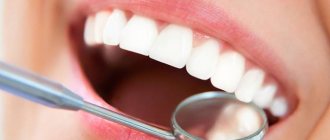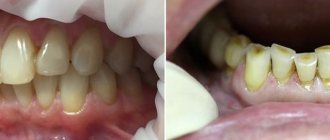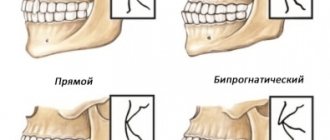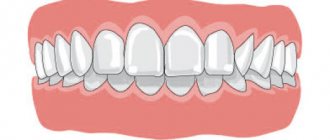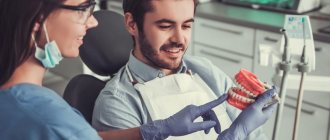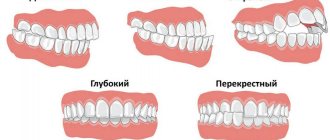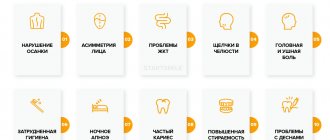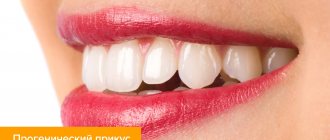- Types of malocclusion
- Causes of deformation
- Consequences of pathology
- Ways to correct deformity
Bite is the position of the teeth of the upper and lower jaws when they are completely closed. In the normal position, the upper and lower rows of teeth are located symmetrically, the incisors of the upper jaw slightly cover the lower ones. There should be no asymmetry or gaps between adjacent teeth.
Types of occlusion defects and methods of their correction
Scientists have calculated that only 40% of the planet's inhabitants are the happy owners of an ideal bite. All others have deviations from the norm to one degree or another. Defects can be critical when they have a negative impact on human health, and practically unnoticeable, not leading to moral or physical discomfort.
The picture below shows occlusion anomalies:
Modern orthodontics includes several methods for correcting malocclusion:
- using braces;
- through surgery;
- using myotherapy (physical exercises) and non-braces corrective devices.
At what age should you start correcting your bite?
Dentists believe that occlusion correction can be carried out at any age using appropriate techniques. Thus, children are not treated with braces because their skeletal system is in active growth, and the bones, including the dentofacial apparatus, have not yet formed. Therefore, young children, before they have permanent teeth yet, are treated with myotherapy, plates and trainers. Note: such methods are used in the presence of non-critical developmental defects. Complex congenital pathologies that have a negative impact on the health or quality of life of the baby are treated surgically.
The optimal period of treatment with braces is from approximately 12 to 16 years. At older ages, the process takes longer.
Important: some dental anomalies can be corrected without the use of braces. The possibility of such treatment is determined by the doctor.
Corrective exercises – myotherapy
As a rule, myotherapy is an addition to the correction of occlusion using various orthodontic devices or as the main method in the treatment of children from 4 to 8 years old. Physical exercises help develop and strengthen facial muscles, stimulate bone growth, and have a positive effect on trophic processes.
Let's look at some effective exercises:
- to correct a deep bite: stand straight with your chin raised as much as possible. Move the lower jaw forward, then return to its original position. Repeat 15 – 17 times;
- to correct open occlusion: take a pencil (you can put a rubber tube on it), squeeze it with your teeth with adequate force. Perform for 4 – 5 minutes;
- with a crossbite: open your mouth as wide as possible, move your jaw towards the defect, close your jaws in the correct position for 5 seconds, then relax, then repeat the exercise again;
- to correct mesial occlusion: use your tongue to press on the inside of the front part of the upper dentition. Perform the exercise for 5 minutes.
Important: when performing any exercises of the myogymnastics complex there should be no pain. After each approach, you need to let the muscles relax for 1 minute.
Records
Vestibular plates are removable orthodontic devices. This means that they can be removed for a while, for example, to eat or brush your teeth. The plate for correcting pathologies is made individually for each patient using personal casts of the jaws.
The base of the plate is a plastic base that is adjacent to the palate. Arcs, clasps and screws are integrated into it. The base color can be neutral or colored.
These devices are mainly used in childhood and adolescence, when the dental system is not yet fully formed and therefore the dental elements are able to move relatively easily under the influence of directed force. The plates are also used to correct pathologies in adult patients, but only in mild cases.
Methods of therapy for correcting bite
Correcting a bite most often means exclusively wearing braces. Indeed, they are often used (and not only for children), but other methods are also used in orthodontics. They can be divided into two groups - surgical and non-surgical.
Surgical methods
Surgical intervention is necessary in three cases:
- when there is high crowding, when it is necessary to remove quarter premolars to make room for other teeth;
- with serious jaw abnormalities;
- to speed up treatment.
Severe pathologies of the jaw bones, which lead to malocclusion and disturbances in swallowing and breathing, cannot be corrected without surgery. During the operation, the surgeon cuts the bone tissue in the places where the teeth need to be moved. At this time, the patient is under general anesthesia in the inpatient department. Rehabilitation after surgery takes up to three weeks. After the tissues are restored, the jaw will have to be developed. Most often, additional treatment is required: the doctor prescribes braces, which must be worn for at least six months. The type of braces, duration of wearing them, and location depend on the current state of the bite.
Surgery can also be used to shorten the treatment time for malocclusion. Orthodontists use what is called a corticotomy, a small operation performed after braces are installed.
About a week after installation, the patient comes to the periodontist, who uses a piezotome to make small incisions in the gums. The entire operation takes about 30 minutes and is performed under local anesthesia. Occasionally, sedatives are also used - general anesthesia is usually not needed.
After corticotomy, the patient will have to visit the orthodontist and periodontist several more times to remove sutures, monitor the condition of the gums and correct the braces. The operation significantly speeds up treatment – by 3–6 months.
Important: surgical intervention is prescribed only in adulthood, after the jaw is fully formed (usually after 16 years). There are a number of standard contraindications: HIV, cancer, heart disease, etc.
Treatment without surgery
If we are not talking about serious pathologies of the jaw, orthodontists and their patients do without surgical treatment methods. Correction of the bite occurs through the installation and long-term wearing of braces, mouthguards and other devices.
Braces are the most effective way to eliminate pathology. They are a power arch with brackets that are secured to the teeth. The arch provides constant pressure on the teeth, and they gradually move, taking the right place.
Braces are worn without interruption. They are removed only at an appointment with the orthodontist, during correction. Over the entire period of treatment (which ranges from 6 months to 3 years), several visits to the doctor may be required. The procedure and duration of treatment depend on the condition of the teeth and the chosen braces system. Thus, self-ligating ones do not require too frequent visits to the orthodontist.
In addition to braces, there are other methods of therapy. Thus, mouthguards are often used - removable devices made of transparent material, and if we are talking about three, microprosthetics (veneers) are chosen.
Trainers
Orthodontic trainers are removable silicone covers for the teeth. They are worn for several hours a day: at night and for 2–4 hours during the day. They are used to correct occlusion in children and in simple situations (for example, when there are gaps between dental elements) in adults.
There are several types of trainers:
- standard for the initial stage of treatment - made of soft pink silicone. This period lasts about six months. The main goal is to influence the position of the jaws and facial muscles;
- standard for the final stage - made from harder blue silicone. They directly influence the movement of teeth in the dental row;
- Lm-activators are trainers, the unique feature of which is that they can be used before all teeth erupt, when the process is just beginning. Their use allows the teeth to settle into place immediately after eruption;
- myobraises – allow for early correction in a natural way, from the age of 3 years. The system does not work on the consequence, but on the causes of the formation of malocclusion. Myobraises are worn for 1 hour during the day and worn throughout the night.
How to choose a good dentist for yourself, a child and a teenager?
In our work, we try to provide comprehensive treatment to our patients. Everyone knows that recommendations from friends and family are the main reason for choosing not only a dentist, but also other doctors. This is the so-called “word of mouth”, which was, is and will be.
Of course, now is the age of the Internet, everyone uses Internet resources, and you can find information by location, by service, and by some other criteria on the Internet. You definitely need to look at the reviews about dentists that are posted on these resources, you definitely need to come, meet and talk with this doctor, look at the place, the cleanliness, the surroundings of the dental clinic, its history and professional experience - these are all the necessary things that will subsequently lead to your choice. You need to summarize all these indicators, divide the piece of paper into two parts, write down the pros and cons. And where you get more advantages, that’s where you need to turn, to these specialists. Everything is very simple!
If there are no familiar doctors, and the patient needs to solve a problem, you still need to choose more according to the clinic, I think. There are clinics that still only accept dentists, orthopedists and hygienists. I believe that in such a narrow specialization as pediatric dentistry, there should be several pediatric doctors in the clinic if you want to bring a child there, if you are thinking about how to correct his bite.
If you come to an adult appointment, then each specialist should be doing his or her own thing, then it will be a more professional approach, that is, you need to look at the clinic as a whole and at the team of doctors as a whole. You must definitely come to the clinic and have a consultation, and perhaps go through more than one or two - this is a serious situation, so you need to carefully approach the choice and try, watch, visit, read and then make a choice.
Mouth guards
Mouthguards, or aligners, are removable plastic or silicone transparent covers on the teeth. Made individually for a specific patient. They are worn constantly and are removed only for eating and hygiene procedures.
They are practically invisible, so they do not cause moral discomfort. The therapeutic effect is determined by a soft force effect on the dental elements, causing them to move in a given direction. The main disadvantage is the inability to eliminate particularly complex defects.
Important: the effectiveness of mouth guards for correcting malocclusion depends not only on the severity of the clinical case, but also on strict self-discipline. Failure to comply with the orthodontist's instructions will negate all efforts made.
Benefits of aligner treatment
Why are many people afraid of having braces? Mainly because this design creates a lot of inconvenience in everyday life. It is unaesthetic, difficult to care for, imposes significant restrictions on the choice of food products, and causes significant discomfort and pain immediately after installation and after each activation procedure.
All this is irrelevant for patients with aligners. The mouth guards can be removed for cleansing, eating, or attending a significant event. They do not affect diction, which is very important for people who often speak in public. You can take pictures with them, smiling “with all 32 teeth,” communicate, kiss. In general, live a normal life and not feel any restrictions.
In addition, aligners have other strengths:
- the material from which the mouthguards are made does not absorb pigments from food and drinks, and therefore does not darken over time;
- biosilicone is a hypoallergenic material, so it can be used without the risk of complications even in people with polyvalent allergies;
- uniform distribution of pressure over the entire surface of the dental crown provides a softer and more gentle effect on periodontal tissue;
- the absence of discomfort and restrictions contributes to maintaining high motivation and adherence to treatment on the part of the patient until the very end of the correction course;
- the final result of the correction is known in advance, since all stages of treatment are planned using a special computer program.
